So what does a $45,000 Arri ALEXA Mini camera have in common with a $6000 URSA Mini Pro G2? A lot actually and it might be worth taking a look at why there is such a high price difference.
If you were to talk to a lot of Hollywood cinematographers you would think the best and only worth cameras to look at these days are from Arri. Definitely their new line of full frame cameras have some impressive features and an even more impressive image quality. Of course not all new projects are being shot on the full frame line of cameras from Arri. In fact majority of films are still shot on the older Arri Alexa, Amira and the very popular Alexa Mini. The Arri ALEXA Mini was originally designed as a B camera for the bigger Arri ALEXA. In fact Arri designed the Mini after lots of requests from cinematographers who loved the “ARRI look” but wanted something smaller and easier to work with that can be mounted on a gimbal or a drone.
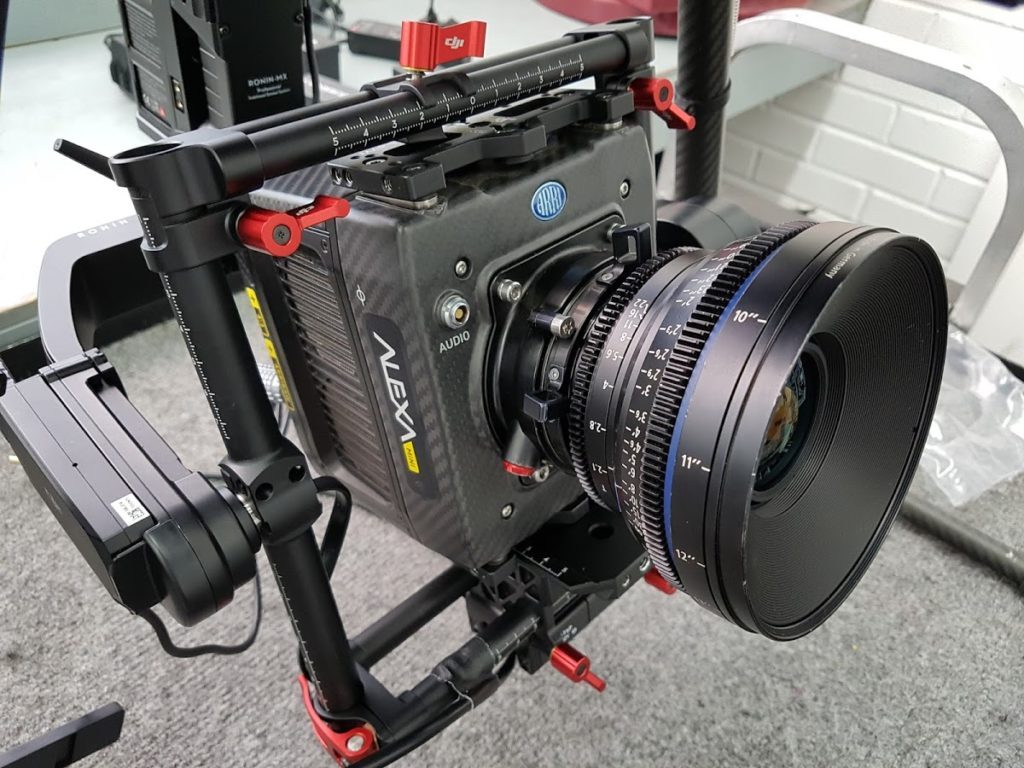
Some compromises had to be made with the Arri Alexa Mini vs it’s big brother. Despite the compromises the ALEXA Mini is still an amazing camera and in fact very quickly became even more popular then the full size Arri Alexa, mainly because of it’s smaller size. I know that I myself prefer to work with smaller cameras because when the need ever arises I can always build up a smaller camera but I can’t shrink a large cinema camera.

Now how does the new URSA Mini Pro G2 compare to the Arri Alexa Mini? I have had a chance to work with both cameras and I can honestly say that in terms of the image quality itself there really isn’t any advantage or disadvantage between the two. I will not say that they are the same because they’re not. These are two different cameras and they both have their own look. Having said that, the look both cameras produce is actually very similar. I haven’t yet had a chance to shoot with both of these cameras on a project side by side but here is a fun music video shot by DP Wojciech Kielar and colored by Ryan McNeal.
Diplo’s “So Long” Official Music Video was shot with the URSA Mini Pro together with the ALEXA Mini and the Angenieux EZ Series lenses. Mostly on the 15-40mm f/2.
Both cameras were used side by side on this video and as you can see when properly graded you can’t tell which shots were from the URSA Mini and which were from the ALEXA Mini. Here is what the DP has to say after shooting the video:
“Overall, I didn’t have any complaints on set with either camera, and both cameras delivered a wonderful image to work within a post. We shot Log on the ALEXA MINI and BlackMagic Raw on URSA Mini Pro. Our colorist, Ryan McNeal at RKM Studios, was very happy to see how well both cameras matched up.”
Here’s what the colorist Ryan McNeal had to say:
“The dynamic range on Blackmagic Raw felt very comparable to ARRI Prores. The DP and I never felt like we had missed out on information in the highlights or shadows. The wide dynamic range gave plenty of range to match, and in the end, the viewer won’t be able to tell the difference. Overall the image quality on Blackmagic Raw feels very sharp and clean. There was no excessive noise, and it feels decidedly “high resolution.” Alexa tends to be soft compared to other 4K+ cameras, as well as clean.”
To my eye and tests both cameras have an almost identical dynamic range even thought the ALEXA Mini is advertised as having 14 stop of light and the URSA Mini 15 stops. Also in terms of the colors both cameras are very similar. Both exhibit an amazing range of color and the science behind processing all that data produces very cinematic yet natural images. Most importantly the skin tones on both cameras look amazing. In my experience the biggest noticeable difference is that when shooting in ProRes Raw on both cameras the Arri ALEXA Mini is a bit softer than the URSA Mini. This isn’t a bad thing, in fact many times cinematographers will put filters to soften the image since an overly sharp footage tends to look more like cheap video. The URSA Mini processes the images in camera a bit sharper than the Arri ALEXA Mini but of course if you shoot in the Blackmagic RAW (BRAW) format you can get around that and adjust the sharpening to your likening in post. That brings me to the next point, the recording formats.
Recording Formats
The Arri ALEXA Mini can shoot Apple ProRes and ArriRAW. In real world situations however I and most cinematographers that work with this camera end up shooting in ProRes since the RAW format is just too large and not as easy to work with as ProRes. The URSA Mini however has an amazingly easy to use RAW format called BRAW. It is all contained in a single file and it comes with lots of quality and compression versions to choose from. The URSA Mini of course also records in all the formats of Apple ProRes but I find myself never shooting in that format unless a client specifically asks for it. So in terms of the recording format I think the URSA Mini has more to offer than the Arri ALEXA Mini.
Recording Media
What about the media that the cameras accept? Again, in that factor the URSA Mini beats the Arri ALEXA Mini. The URSA Mini has two CFast card slots and 2 SD card slots that you can record on to PLUS there is even a USB-C port for plugging in an external hardrive so you can record to it directly. This is something that no other camera manufacturer has yet had a chance to implement. The ALEXA Mini on the other hand records to a single CFast card slot or an external Codex recorder which is not a very affordable or practical method.
Weight and Size
In pure weight both cameras are pretty much identical when you get them right out of the box. They both weight in at 5 pounds or 2.3kg. Of course that is just the camera body. After you add the accessories to make the cameras work they both will get bigger and heavier. How heavy really depends on how you outfit the cameras. In terms of the size both camera are again very similar, with the URSA Mini being a bit longer.
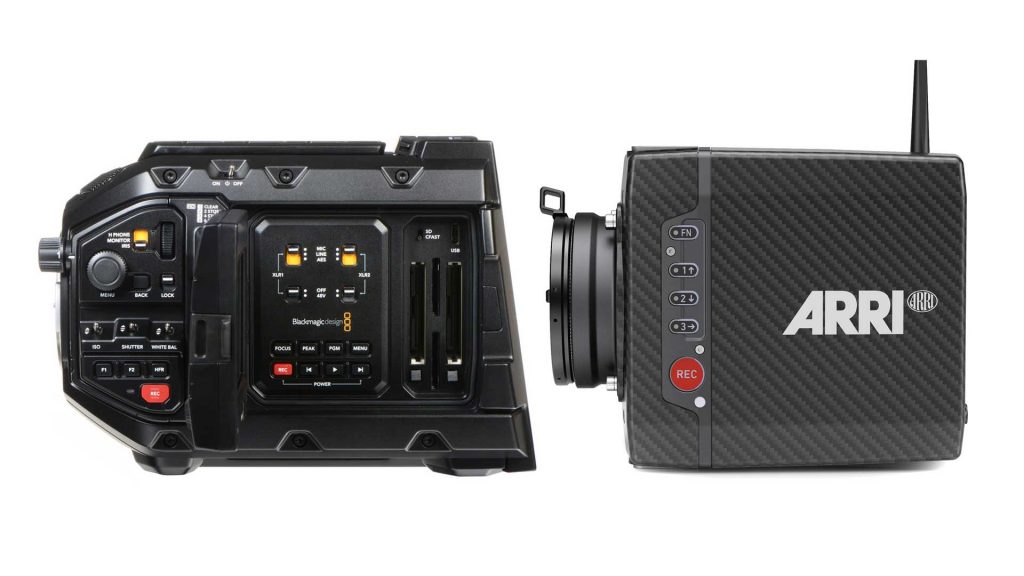
Camera Build
The URSA Mini body is made from made from magnesium alloy to keep the weight down yet make the camera very sturdy. Similarly the Arri ALEXA Mini is made from a durable yet light material which is carbon fiber.
Ergonomics
The Arri ALEXA Mini is very simple looking. It has very few buttons. It is designed so it can be mounted on a drone or gimbal and remotely operated through cables or WiFi. Similarly the URSA Mini Pro can be operated via WiFi or LANC port but it has substantially more buttons on the camera body then the ALEXA Mini. This is in part because it is designed to be operated via the menu system or just using the physical buttons. It’s always nice to have the option of both as a camera operator. Also the URSA Mini Pro has a built in touch screen that is great for both previewing your shots but also for navigating the menus. The ALEXA Mini doesn’t have any display. You will therefore need to spend more money on a monitor that you can connect via one of it’s I/O ports that are located on the back. The URSA Mini also has the same I/O ports located in the back plus more in the front for connecting an EVF and sending power out to the EVF.
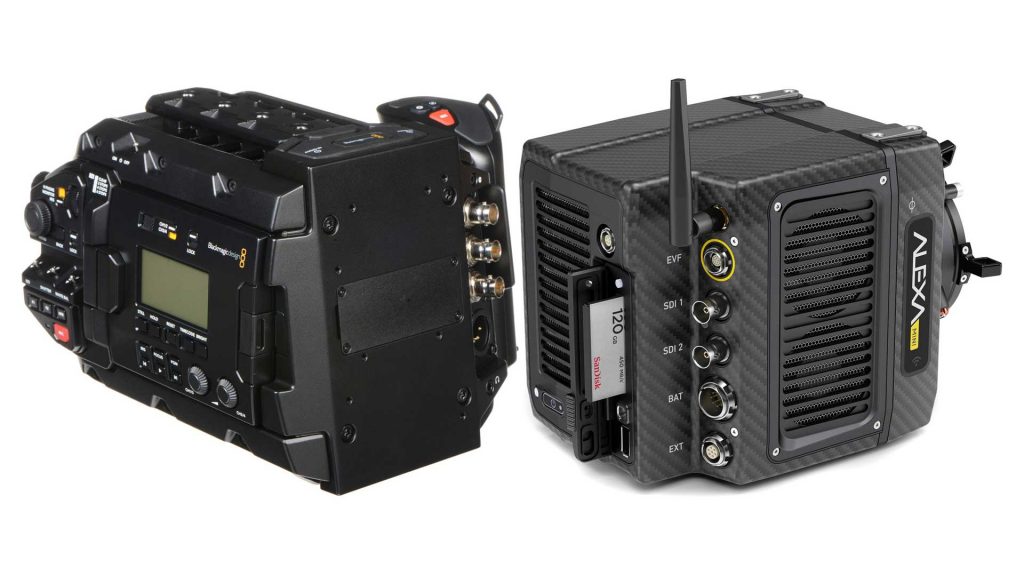
One thing I like more about the URSA Mini Pro is that it’s a lot easier and way cheaper to rig this camera out for proper handheld operation. The URSA Mini has a designated space in the back of it’s body for attaching a battery plate where as the ALEXA Mini has cooling fans and the recording media access bay in the back. This means that in order to put a battery in the back of the ALEXA Mini you will need to offset it further back using rails which results in a bigger and more clunky final rig versus the URSA Mini Pro. The same goes for mounting a top handle on the cameras. There are dedicated 1/4 inch 20 threads on the top and middle of the URSA Mini which make this way easier then with the ALEXA Mini.
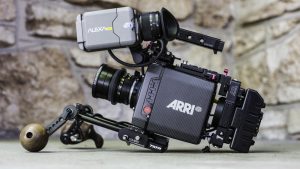
Another big plus of the URSA Mini versus the Arri ALEXA Mini is the audio ports and recording options. The ALEXA has a single mic plug but the URSA Mini includes 2 powered XLR ports and physical buttons on the side of the camera for controlling the audio levels.
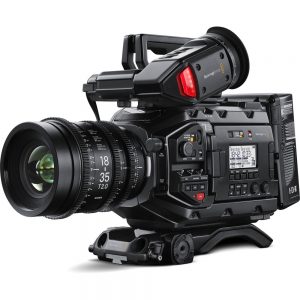
Weather Sealing
The Arri Alexa Mini is great when it comes to weather sealing as it comes pretty much completely ready to battle the dustiest or wettest environments. Arri advertises the camera as splash and dust proof with sealed electronics. The URSA Mini Pro on the other hand doesn’t advertise such claims. In fact the URSA Mini has a big vent opening on the top and bottom of the camera but personally I wouldn’t worry. I’ve used the first generation URSA Mini 4k and then the 4.6K cameras on lots of jobs around the world without any worries. I’ve shot a feature film in dusty and rainy environments of India. I’ve also shot in the cold frigid north winters of Canada on the URSA Mini Pro without any problems. In fact when shooting a few times side by side with different RED cameras I found the URSA Mini handled the weather better not to mention the battery life was way above and reliability plus start up time on the URSA Mini always saved my day.
Menu System
Both cameras have a simple and easy to understand menu system which is a must when using a camera on a complicated film shoot. The last thing any DP wants to worry about is having to find a particular settings in the menu. I would say the URSA Mini really is a step above the ALEXA Mini because to navigate the menu is even faster thanks to it’s many dedicated buttons plus the amazing touch screen.
Lens Mounts
The Arri ALEXA Mini and the URSA Mini are designed as cinema cameras. So they need to adopt to the various lens options that filmmakers have to choose these days. That is why both cameras come have an interchangeable lens system. The URSA Mini normally comes with an EF Mount that can be replaced with mounts for Nikon, PL or B4 lens mounts for a lot cheaper than the Arri ALEXA Mini. The ALEXA Mini on the other hand comes without a lens mount so that is another expense to consider when thinking of investing in that camera. Also Arri doesn’t make a Nikon mount for the ALEXA Mini like the Blackmagic Design’s mount for the URSA Mini.
Sensor
These cameras are similar in many ways that I’ve already mention and the sensors are no different. They’re both Super 35mm image CMOS sensors which produce similar image quality as mentioned above.
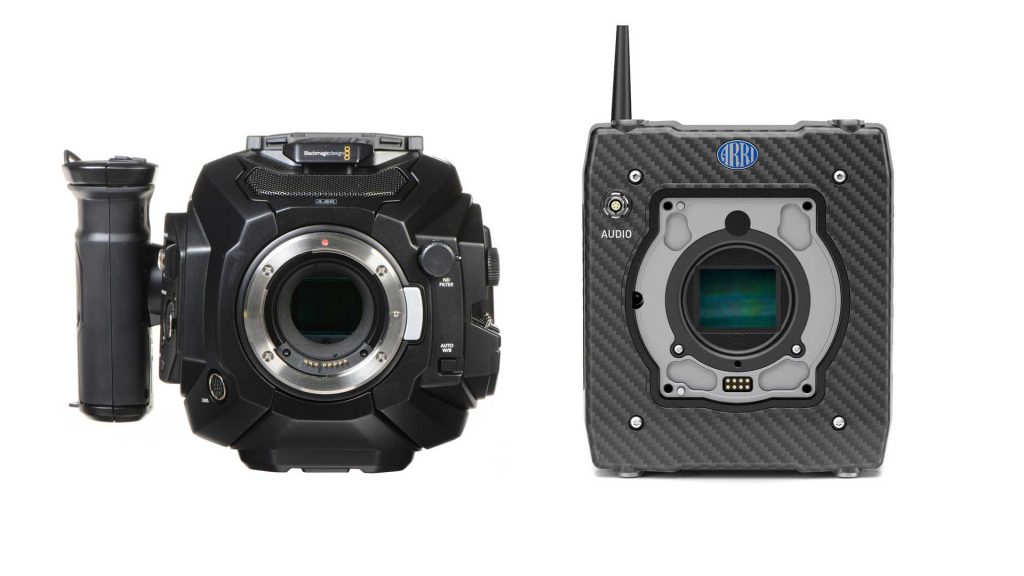
Resolution
The Arri ALEXA Mini can record in HD and up to UHD 4K resolution while the URSA Mini can do that plus DCI 4K and 4.6K resolution. This gives the URSA Mini a slight advantage but personally I don’t think resolution is as important as the overall look of the image, which I think both cameras are equally as good at.
Frame Rates
When it comes to frame rates the ALEXA Mini can record up to 200 frames per second in HD which produces beautiful slow motion. The URSA Mini Pro G2 can actually go up even higher up to 300 fps in HD. The URSA Mini can also record 4.6K up to 120fps and 4K up to 150fps. Both cameras can produce great looking slow motion effects for most scenarios encountered on a typical film, music video or commercial shoot.
Final thing I wanted to talk about is the stigma around Blackmagic Design cameras. Blackmagic Design is a fairly new camera manufacturer versus Arri which was founded in 1917 and has produced lots of different film and now digital film cameras. This alone creates an image of Arri as “THE brand” and an “expert” in all things cameras, even though for most of Arri’s existence they did not develop digital sensor but were more of a mechanical and hardware company. They produced reliable camera systems but the look was always determined by the film stock and the artists using these tools. Today however they were forced to create a sensor that replaces the film stock. They have without a doubt produced cameras that create an amazing film like look but that is not to say that Blackmagic hasn’t done the same with their line of the URSA Mini cameras. The G2 is just another version with improved slow motion options but their previous generation URSA Mini Pro or even the earlier URSA Mini 4.6K cameras are in my opinion just as worthy of the silver screen as any of Arri’s cameras.
In the end the brand name and it’s network that Arri established in the film market over the last 100 years really helps them sell their cameras. You mention Arri and most filmmakers know what it is. You mention Blackmagic and… well… most filmmakers might think you are talking about actual black magic. Does Arri have a bigger network and more reliable service than Blackmagic? Of course! I won’t deny it. So if you are shooting a big budget production where the cost of the camera gear is a fraction of the overall budget then you will go with Arri because in the end you need to make sure that if the camera brakes down you can replace it or service it quickly so you don’t slow down this expensive production. But on an medium to small sized production where often the cinematographer owns his camera there is no reason to spend over $45K on a ALEXA Mini. Get the URSA Mini Pro G2! You know the final image will look just as good. The camera will be easier to work with because of it’s ergonomics. Not to mention you can concentrate on the job instead of how many payments you have left on the camera. Also if the URSA Mini Pro does break down on you in those rare cases you can always just go and buy a new one and still spend way less money on an Arri ALEXA Mini. I think instead of worrying about brand names, filmmakers should worry more about being as creative as we can be.
You can get the URSA Mini Pro G2 from online on eBay, B&H Photo Video Store, Adorama and Amazon.
You can also get the Arri ALEXA Mini online from B&H. Plus you can find it used on eBay.

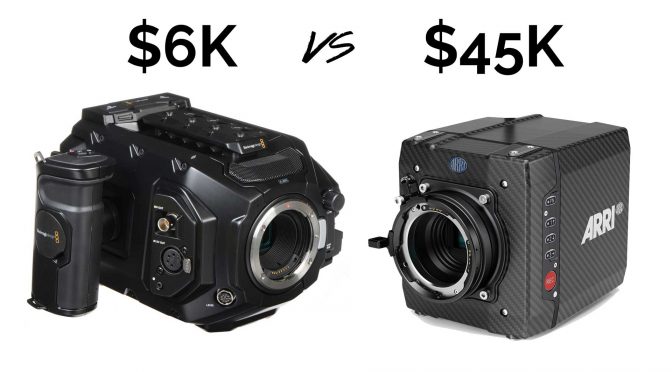
There is so much wrong with this article
Both cameras does not offer Prores Raw ex- or internal
The Alexa Mini offers the same Dynamic Range like Amira, Alexa (XT, SXT, W). Its even the same sensor, the Alev 3. Even Alexa 65, LF and Mini LF has the same sensor architecture, except the size of the sensor.
The recording options of the Mini are almost the same like SXT or W. The Mini is limited to 48 fps 2.8k Arriraw, 30 fps 3.4k Arriraw & does not have 3.2k Arriraw 16×9, where the SXT can do 120 fps 2.8k/ 3.2k Arriraw and 90 fps 3.4k. But the SXT is only capable of max. 120 fps, not 200 fps Prores 2k 4444 & XQ like the mini.
The 200 fps is a downscaled 2k from the whole Sensor, the 300 fps from the Ursa Mini Pro is sensor cropped.
The Alexa mini has a 3.4k sensor, 4k is just upscaled and only possible with Prores.
Nobody claimed the arri cameras can record apple prores RAW. It says they record various formats of ProRes … also they record in RAW which is ArriRAW.
Very helpful article. I always believe in story other than gear. Audience don’t care about your camera they only come to see your story. Thanks.
Claimed DR vs real world DR are two different things. Manufacturers manipulate the numbers these day to satisfy the undiscerning wannabe filmmakers. Up to the present day not a single camera have come to touch the DR of Alexa. And certainly not Ursa. Arri have actually been quite conservative in rating their camera’s DR. It’s more like 15 usable stops. While Ursa has no more than 12-13 usable stops. Depending on what is acceptable in the shadows – a subjective thing. Most of those cameras which claim higher than 12 stops DR severely distort underexposed image by depleting it of chroma and/or applying noise reduction. Current generation of sensors have reached their limits. Alexa gets more range by applying dual readout – for highlights and for shadows. Yet, whatever the truth, all these 12stop-actual-DR-shooting cameras are more than enough in capable hands.
Agree totally here with an additional consideration, which is how various cameras achieve the claimed DR. In Alexa’s case it’s by pumping a bit more power into the green/luminosity channel. A clever way of returning more texture there but also results in a bias in colour science that is corrected in software after the sensor. This is part of what results in the sensor being a little softer than others.
I’m a fan of the Blackmagic cameras. I love the look that comes really close to Arri cameras and the simple workflow. Your article once again showed me that I chose the right company for me.
Thanks for the effort this article has cost.
Best regards
Nick Geissler Films
Since I started buying BMD I never stopped. I have had and I still have ALL of their cameras. I usually pay them with a couple of jobs and I can always upgrade my cameras to the next new model, without loosing money or having money stuck for 2 or 3 years before I pay for a 50k camera. URSA Mini is amazing and really…if it wasn’t sometimes for the client eye candy I wouldn’t use Alexa. I prefer having 3 BM cameras in case one breaks down which Never happened to me. Thank you Black magic and Tom to reinforce what I have already confirmed.
Excelente, soy usuario de Bm y actualmente tengo la Ursa Mini 4k Raw, y me va muy bien.